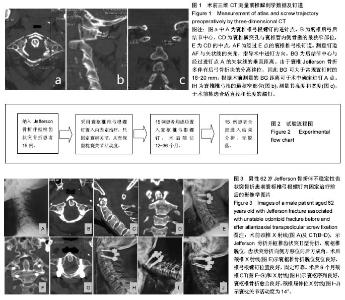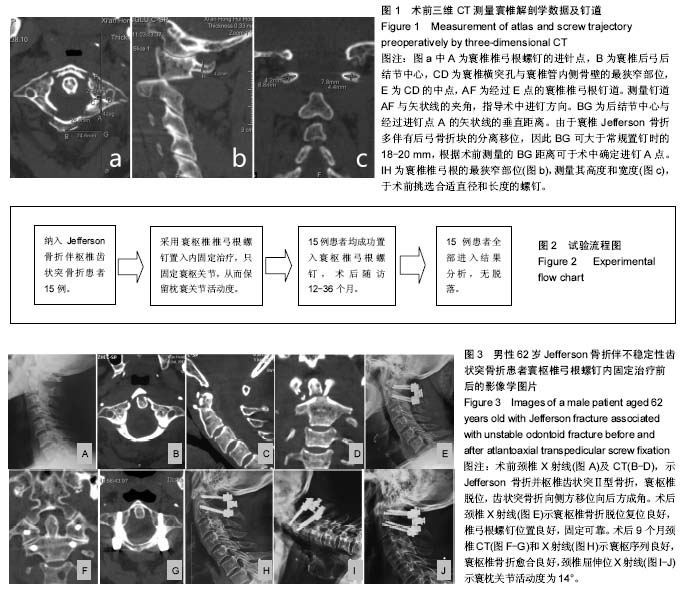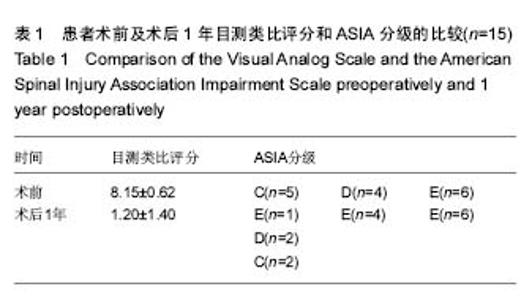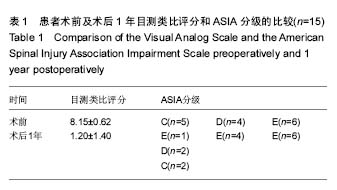Chinese Journal of Tissue Engineering Research ›› 2017, Vol. 21 ›› Issue (31): 4957-4962.doi: 10.3969/j.issn.2095-4344.2017.31.007
Previous Articles Next Articles
Single segment fixation with atlantoaxial pedicle screws in the treatment of Jefferson fracture combined with unstable odontoid fracture
Qu Wei, Yan Liang, Song Zong-rang, Liu Ji-jun, Wu Qi-ning, Hao Ding-jun
- Department of Spinal Surgery, Xi’an Honghui Hospital, Xi’an Jiaotong University, Xi’an 710054, Shaanxi Province, China
-
Online:2017-11-08Published:2017-12-01 -
Contact:Hao Ding-jun, Chief physician, Professor, Department of Spinal Surgery, Xi’an Honghui Hospital, Xi’an Jiaotong University, Xi’an 710054, Shaanxi Province, China -
About author:Qu Wei, Master, Attending physician, Department of Spinal Surgery, Xi’an Honghui Hospital, Xi’an Jiaotong University, Xi’an 710054, Shaanxi Province, China -
Supported by:the National Natural Science Foundation of China, No. 81401843
CLC Number:
Cite this article
Qu Wei, Yan Liang, Song Zong-rang, Liu Ji-jun, Wu Qi-ning, Hao Ding-jun. Single segment fixation with atlantoaxial pedicle screws in the treatment of Jefferson fracture combined with unstable odontoid fracture[J]. Chinese Journal of Tissue Engineering Research, 2017, 21(31): 4957-4962.
share this article

2.1 参与者数量分析 按意向性处理,15例患者纳入本研究,均完成随访,全部进入结果分析,无脱落。试验流程图见图2。 2.2 术中及术后随访情况 平均手术时间(150±41) min (120-270 min),平均失血量(246±95) mL (160-500 mL)。所有患者寰枢椎骨折脱位复位良好,术中无脊髓、神经根和椎动脉损伤发生,均成功置入寰枢椎弓根螺钉。术后随访12-36个月。术后1年所有寰枢椎骨折全部愈合,融合手术的患者后方椎板间植骨融合良好,随访期间未见内固定松动、断裂。术后1年颈痛目测类比评分较术前明显改善(P < 0.05),术前脊髓不完全损伤者共9例,7例患者术后神经功能明显恢复(表1)。术后寰枕关节活动度平均(14.6±2.8)°。 2.3 典型病例 男性患者,62岁,高处坠落伤,颈痛,活动受限,ASIA D级,Jefferson骨折合并枢椎齿状突Ⅱ型骨折,寰枢椎脱位。给予牵引治疗后,复位效果不佳,后采用手术治疗,给予患者后路寰枢椎复位,寰枢椎弓根螺钉固定手术,患者术后9个月寰椎及齿状突骨折愈合良好,屈伸位X射线示寰枕关节活动度保留。颈痛目测类比评分由术前8分改善到术后1年0分,术后1年脊髓神经功能恢复至正常(ASIA E级),见图3。"

| [1] 田伟.关于寰枢椎复合骨折的治疗[J]. 中国脊柱脊髓杂志,2013, 23(5): 388-389.[2] Jefferson G. Fracture of the atlas vertebra. Report of four cases, and a review of those previously recorded. Brit J Surg. 1919; 7(27): 407-422.[3] 胡东才,王建平. Jefferson骨折的相关勘误及寰椎骨折分型[J].中国脊柱脊髓杂志, 2014, 24(12):1135-1136. [4] Longo UG, Denaro L, Campi S, et al. Upper cervical spine injuries: indications and limits of the conservative management in Halo vest. A systematic review of efficacy and safety. Injury. 2010; 41(11):1127-1135.[5] Ergün K, Adem A, Olcay E, et al. Halo vest treatment of upper cervical vertebral fracture. J Clin Exp Inv. 2013; 4(2):171-174.[6] Bransford RJ, Stevens DW, Uyeji S, et al. Halo vest treatment of cervical spine injuries: a success and survivorship analysis. Spine(Phila Pa 1976). 2009; 34(15):1561-1566.[7] Vieweg U, Schultheiss R. A review of halo vest treatment of upper cervical spine injuries. Arch Orthop Trauma Surg. 2001; 121(1-2):50-55.[8] Deen HG, Tolchin S. Combination jefferson fracture of C1 and type II odontoid fracture requiring surgery: report of two cases. Neurosurgery.1989; 25(2):293-297.[9] Hein C, Richter HP, Rath SA. Atlantoaxial screw fixation for the treatment of isolated and combined unstable jefferson Fractures-experiences with 8 Patients. Acta Neurochir(Wien). 2002; 144(11):1187-1192.[10] Guiot B, Fessler RG. Complex atlantoaxial fractures. J Neurosurg. 1999; 91(2 Suppl):139-143[11] Ben Aicha K, Laporte C, Akrout W, et al. Surgical management of a combined fracture of the odontoid process with an atlas posterior arch disruption: a review of four cases. Orthop Traumatol Surg Res. 2009; 95(3):224-228.[12] Strohm PC, Muller Ch A, Kostler W, et al. Halo-fixator vest--indications and complications. Zentralbl Chir. 2007; 132(1):54-59.[13] Liu C, Kuang L, Wang L, et al. Management of combination fractures of the atlas and axis: a report of four cases and literature review. Int J Clin Exp Med. 2014; 7(8): 2074-2080.[14] Kesterson L, Benzel E, Orrison W, et al. Evaluation and treatment of atlas burst fractures(Jefferson fractures). J Neurosurg.1991; 75(2):213-220.[15] Satyarthee GD, Vaghani G, Mahapatra AK. Surgical management of combined fracture of atlas associated with fracture of axis vertebrae(CAAF): Case series. Romanian Neurosurgery. 2015; 29(3):335-341.[16] Steinmetz MP, Mroz TE, Benzel EC. Craniovertebral junction: biomechanical considerations. Neurosurgery. 2010; 66 (3 Suppl): 7-12.[17] Tan M, Wang H, Wang Y, et al. Morphometric evaluation of screw fixation in atlas via posterior arch and lateral mass. Spine. 2003; 28(9):888-895. [18] Harms J, Melcher RP. Posterior C1-C2 fusion with polyaxial screw and rod fixation. Spine. 2001; 26(22):2467-2471.[19] Rizvi SA, Fredo HL, Lied B, et al. Surgical management of acute odontoid fractures: surgery-related complications and long-term outcomes in a consecutive series of 97 patients. J Trauma Acute Care Surg. 2012; 72(3):682-690.[20] Pawar AY, O'Leary PF. Combined Type II Odontoid Fracture with Jefferson's Fracture Treated with Temporary Internal Fixation. Asian Spine J. 2015; 9(6):966-970. [21] Kalantar SB. Fracture of the C1 and C2 vertebrae. Seminars in spine surgery. 2013; 25(1):23-35.[22] Walters BC, Hadley MN, Hurlbert RJ, et al. Guidelines for the management of acute cervical spine and spinal cord injuries: 2013 update. Neurosurgery. 2013; 60(Suppl 1): 82-91.[23] Julien TD, Frankel B, Traynelis VC, et al. Evidence-based analysis of odontoid fracture management. Neurosurg Focus. 2000; 8(6): e1.[24] Kim SK, Shin JJ, Kim TH, et al. Clinical outcomes of halo-vest immobilization and surgical fusion of odontoid fractures. J Korean Neurosurg Soc. J korean Neurosurg Soc. 2011; 50(1):17-22.[25] Dickman CA, Hadley MN, Browner C, et al. Neurosurgical management of acute atlas-axis combination fractures. A review of 25 cases. J Neurosurg. 1989; 71(1):45-49.[26] Anderson LD, D’Alonzo RT. Fractures of the odontoid process of the axis. J Bone Joint Surg Am. 1974; 56(8):1663-1674.[27] Wang J, Zhou Y, Zhang ZF, et al. Comparison of percutaneous and open anterior screw fixation in the treatment of type II and rostral type III odontoid fractures. Spine. 2011; 36(18):1459–1463.[28] 刘文亮,蒋欣浩,黄威,等.齿状突骨折的分型与诊治研究进展[J].骨科,2015,6(1):53-56.[29] Casper DS, Mckenzie J, Schroeder GD. Controversial cervical spine fractures: Classification and treatment. Semin Spine Surg. 2017; 29 : 41-49.[30] Eysel P, Roosen K. Ventral or dorsal spondylodesis in densbasal fracture-a new classification for choice of surgical approach. Zentralbl Neumchir. 1993; 54(4):159-165.[31] 黄威,蔡贤华,李彦锦. II型齿状突骨折手术治疗与并发症分析[J]. 中国矫形外科杂志, 2013,21(4):359-362.[32] Elliott RE, Tanweer O, Boah A, et al. Outcome comparison of atlantoaxial fusion with transarticular screws and screw-rod constructs: meta-analysis and review of literature. J Spinal Disord Tech. 2014; 27(1):11-28.[33] 柳超,王前,张杰峰,等.不同内固定手术方式治疗寰枢椎复合骨折稳定性的有限元分析[J]. 中国脊柱脊髓杂志, 2015, 25(10): 904-911.[34] Haus BM, Harris MB. Case report: nonoperative treatment of an unstable Jefferson fracture using a cervical collar. Clin Orthop Relat Res. 2008; 466(5):1257-1261.[35] 洪波,向铁城,黄象望,等. 寰枢椎椎弓根螺钉经后路固定融合治疗Jefferson骨折伴齿状突骨折[J]. 医学临床研究, 2014,31(1):90-93.[36] 陈卫,丁真奇,康两期,等. 寰枢椎椎弓根螺钉固定治疗Jefferson骨折合并齿状突骨折[J]. 中国脊柱脊髓杂志, 2008, 18(1):50-54.[37] Guo Q, Zhang M, Wang L, et al. Comparison of atlantoaxial rotation and functional outcomes of two nonfusion techniques in the treatment of Anderson-D' Alonzo TypeⅡodontoid fractures. Spine(Phila Pa 1976). 2016; 41(12):e751-758.[38] Ni B, Guo Q, Lu X, et al. Posterior reduction and temporary fixation for odontoid fracture: a salvage maneuver to anterior screw fixation. Spine(Phila Pa 1976). 2015; Spine(Phila Pa 1976). 2015; 40(3): e167-174.[39] Guo Q, Deng Y, Wang J, et al. Comparison of clinical outcomes of posterior C1-2 temporary fixation without fusion and C1-2 fusion for fresh odontoid fractures. Neurosurgery. 2015; 78(1):77-83.[40] Mead LB 2nd, Millhouse PW, Krystal J, et al. C1 fractures: a review of diagnoses, management options, and outcomes. Curr Rev Musculoskelet Med. 2016; 9(3): 255-262. |
| [1] | Yao Xiaoling, Peng Jiancheng, Xu Yuerong, Yang Zhidong, Zhang Shuncong. Variable-angle zero-notch anterior interbody fusion system in the treatment of cervical spondylotic myelopathy: 30-month follow-up [J]. Chinese Journal of Tissue Engineering Research, 2022, 26(9): 1377-1382. |
| [2] | Jiang Huanchang, Zhang Zhaofei, Liang De, Jiang Xiaobing, Yang Xiaodong, Liu Zhixiang. Comparison of advantages between unilateral multidirectional curved and straight vertebroplasty in the treatment of thoracolumbar osteoporotic vertebral compression fracture [J]. Chinese Journal of Tissue Engineering Research, 2022, 26(9): 1407-1411. |
| [3] | Xue Yadong, Zhou Xinshe, Pei Lijia, Meng Fanyu, Li Jian, Wang Jinzi . Reconstruction of Paprosky III type acetabular defect by autogenous iliac bone block combined with titanium plate: providing a strong initial fixation for the prosthesis [J]. Chinese Journal of Tissue Engineering Research, 2022, 26(9): 1424-1428. |
| [4] | Zhuang Zhikun, Wu Rongkai, Lin Hanghui, Gong Zhibing, Zhang Qianjin, Wei Qiushi, Zhang Qingwen, Wu Zhaoke. Application of stable and enhanced lined hip joint system in total hip arthroplasty in elderly patients with femoral neck fractures complicated with hemiplegia [J]. Chinese Journal of Tissue Engineering Research, 2022, 26(9): 1429-1433. |
| [5] | Li Wei, Zhu Hanmin, Wang Xin, Gao Xue, Cui Jing, Liu Yuxin, Huang Shuming. Effect of Zuogui Wan on bone morphogenetic protein 2 signaling pathway in ovariectomized osteoporosis mice [J]. Chinese Journal of Tissue Engineering Research, 2022, 26(8): 1173-1179. |
| [6] | Wang Jing, Xiong Shan, Cao Jin, Feng Linwei, Wang Xin. Role and mechanism of interleukin-3 in bone metabolism [J]. Chinese Journal of Tissue Engineering Research, 2022, 26(8): 1260-1265. |
| [7] | Xiao Hao, Liu Jing, Zhou Jun. Research progress of pulsed electromagnetic field in the treatment of postmenopausal osteoporosis [J]. Chinese Journal of Tissue Engineering Research, 2022, 26(8): 1266-1271. |
| [8] | Wu Bingshuang, Wang Zhi, Tang Yi, Tang Xiaoyu, Li Qi. Anterior cruciate ligament reconstruction: from enthesis to tendon-to-bone healing [J]. Chinese Journal of Tissue Engineering Research, 2022, 26(8): 1293-1298. |
| [9] | Tian Chuan, Zhu Xiangqing, Yang Zailing, Yan Donghai, Li Ye, Wang Yanying, Yang Yukun, He Jie, Lü Guanke, Cai Xuemin, Shu Liping, He Zhixu, Pan Xinghua. Bone marrow mesenchymal stem cells regulate ovarian aging in macaques [J]. Chinese Journal of Tissue Engineering Research, 2022, 26(7): 985-991. |
| [10] | Hu Wei, Xie Xingqi, Tu Guanjun. Exosomes derived from bone marrow mesenchymal stem cells improve the integrity of the blood-spinal cord barrier after spinal cord injury [J]. Chinese Journal of Tissue Engineering Research, 2022, 26(7): 992-998. |
| [11] | Gao Yujin, Peng Shuanglin, Ma Zhichao, Lu Shi, Cao Huayue, Wang Lang, Xiao Jingang. Osteogenic ability of adipose stem cells in diabetic osteoporosis mice [J]. Chinese Journal of Tissue Engineering Research, 2022, 26(7): 999-1004. |
| [12] | An Weizheng, He Xiao, Ren Shuai, Liu Jianyu. Potential of muscle-derived stem cells in peripheral nerve regeneration [J]. Chinese Journal of Tissue Engineering Research, 2022, 26(7): 1130-1136. |
| [13] | Hou Jingying, Guo Tianzhu, Yu Menglei, Long Huibao, Wu Hao. Hypoxia preconditioning targets and downregulates miR-195 and promotes bone marrow mesenchymal stem cell survival and pro-angiogenic potential by activating MALAT1 [J]. Chinese Journal of Tissue Engineering Research, 2022, 26(7): 1005-1011. |
| [14] | Liang Xuezhen, Yang Xi, Li Jiacheng, Luo Di, Xu Bo, Li Gang. Bushen Huoxue capsule regulates osteogenic and adipogenic differentiation of rat bone marrow mesenchymal stem cells via Hedgehog signaling pathway [J]. Chinese Journal of Tissue Engineering Research, 2022, 26(7): 1020-1026. |
| [15] | Cui Xing, Sun Xiaoqi, Zheng Wei, Ma Dexin. Huangqin Decoction regulates autophagy to intervene with intestinal acute graft-versus-host disease in mice [J]. Chinese Journal of Tissue Engineering Research, 2022, 26(7): 1057-1062. |
| Viewed | ||||||
|
Full text |
|
|||||
|
Abstract |
|
|||||

